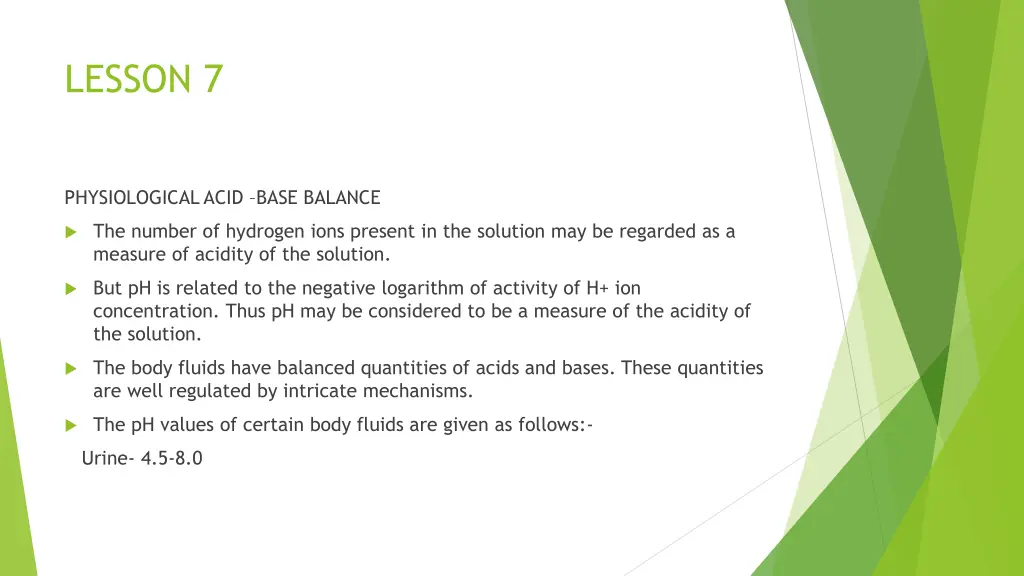
Understanding Physiological Acid-Base Balance
Learn about the importance of pH levels in body fluids, the role of kidneys and lungs in maintaining acid-base balance, and the major buffer systems such as the carbonic acid-bicarbonate system. Explore how these mechanisms regulate blood pH to ensure proper functioning of metabolic processes for survival.
Download Presentation

Please find below an Image/Link to download the presentation.
The content on the website is provided AS IS for your information and personal use only. It may not be sold, licensed, or shared on other websites without obtaining consent from the author. If you encounter any issues during the download, it is possible that the publisher has removed the file from their server.
You are allowed to download the files provided on this website for personal or commercial use, subject to the condition that they are used lawfully. All files are the property of their respective owners.
The content on the website is provided AS IS for your information and personal use only. It may not be sold, licensed, or shared on other websites without obtaining consent from the author.
E N D
Presentation Transcript
LESSON 7 PHYSIOLOGICAL ACID BASE BALANCE The number of hydrogen ions present in the solution may be regarded as a measure of acidity of the solution. But pH is related to the negative logarithm of activity of H+ ion concentration. Thus pH may be considered to be a measure of the acidity of the solution. The body fluids have balanced quantities of acids and bases. These quantities are well regulated by intricate mechanisms. The pH values of certain body fluids are given as follows:- Urine- 4.5-8.0
Blood-7.4-7.5 Gastric juice- 1.5-3.5 Saliva-5.4-7.5 Bile- 6.0-8.5 Semen-7.2-7.6 The organs associated with maintenance of pH are kidneys -which removes excess of acid from the body as acidic urine. The lungs are also involved in the maintenance of pH. As most metabolic reactions take place within a very narrow pH range, homeostasis of H+ concentration becomes essential for survival and is done by involving the following major mechanisms Buffer system Elimination of some ions through urine by kidney Through the respiratory centre.
Buffer system Buffer system may consist of a weak acid and the salt of that acid, which functions as a weak base. It does not allow rapid and drastic changes in the pH of a body fluid by converting strong acids and bases into weak acids and bases.Buffers are thus able to remove excess of H+ from the body fluids but not from the body. The major buffer system existing in the body fluids are as follows:- Carbonic acid- bicarbonate buffer system Phosphate buffer system Protein (hemoglobin) buffer system
a.Carbonic acid- bicarbonate buffer system It occurs in plasma and kidneys. It is considered to be an important regulator of blood pH. If there occurs an excess of H+, the bicarbonate (HCO3-) ions act as weak base and accepts H+ to form carbonic acid. The latter dissociates further to yield carbon dioxide and water molecules H+ + HCO3- ------> H2CO3 -------> CO2 +H2O While, if there occurs shortage of H+, the carbonic acid (another component of buffer system) ionizes to release more H+ ions and maintains the pH.
In lungs, for example, oxygen reacts with the protonated deoxyhaemoglobin, releasing protons. These protons combine with the bicarbonates, forming carbonic acid, which then dissociates to yield carbon dioxide and water. Then the carbon dioxide gets exhaled out. Normal metabolism gives rise to more acids than bases, and the blood is made more acidic. Therefore the body needs more bicarbonate salt than it needs carbonic acid. Hence at physiological pH7.4, the plasma is having about 24 mEq/lit of bicarbonates in comparison to 1.2 mEq/lit of carbonic acid (ratio is 20:1).
Phosphate buffer system It is also to maintain the physiological pH at 7.4. As the phosphate concentration is highest in intracellular fluid, the phosphate buffer system is considered to be an important regulator of pH in cytosol. This system occurs in the cell and kidneys. The system consists of monohydrogen phosphate/ dihydrogen phosphate (HPO42- / H2PO42-) anions. It is known to act in the same manner as the carbonic acid-bicarbonate buffer system acts. If there occurs an excess of H+, the monohydrogen phosphate ions acts as the weak base by accepting the proton. HCl + Na2HPO4 ------> NaCl + NaH2PO4 (Strong acid) + (weak base) (salt) + (weak acid) While the dihydrogen phosphate ion can act as the weak acid, and is able to neutralize the alkaline conditions, as NaOH + NaH2PO4 -------> H2O + Na2HPO4 (Strong base) + (weak acid) (weak base)
For example: In kidneys, NaH2PO4 gets formed if excess of H+ in the kidney tubules combine with Na2HPO4. The sodium ion released in this reaction forms sodium bicarbonate by accepting bicarbonate ions. The NaHCO3 then enters the blood. The kidneys are also able to synthesize new bicarbonates (HCO3-) and reabsorb bicarbonate ions that have been filtered, so this important buffer does not get lost in the urine. The H+ that replaces Na becomes part of the NaH2PO4 that goes into the urine. Thus, kidneys are able to maintain pH by the acidification of urine. At physiological pH, the HPO42- / H2PO42- ratio in the intracellular fluid is about 4:1 while in the kidneys it is nearly 1:100 because the urine pH is in acidic range.
Protein (haemoglobin) buffer system It is considered to be the most abundant buffer in body cells and plasma. Proteins are composed of amino acids that are having at least one carboxyl group (-COOH) and at least one amino (NH2) group. When there occurs an excess of hydrogen ions, the amino group acts as a base and accepts the proton. While the free carboxyl group can release protons, so as to neutralize an alkaline condition Thus, protein is able to serve both the functions of acid and base components of a buffer system because of its amphoteric nature. Important amino acid buffers are histidine and cysteine. When CO2 enters the erythrocytes from body cells, it rapidly combines with water to form carbonic acid by involving the carbonic anhydrase enzyme
This carbonic acid dissociates into: - H2CO3 -----> H+ + HCO3- When oxyhemoglobin is able to release its oxygen (O2) to the body cells, it becomes reduced hemoglobin (Hb-). Then it accepts a proton and tends to decrease excess of protons in erythrocytes. In lungs, oxygen combines with protonated deoxyhemoglobin and releases the protons. The latter undergoes combination with the HCO3- forming carbonic acid which then dissociates to yield carbon dioxide and water. The carbon dioxide is then exhaled out. Breathing is also known to play an important role in maintaining the pH of body fluids. H2CO3 H+ + HCO3- CO2 +H2O If the rate and depth of breathing increases, more carbon dioxide (CO2) gets exhaled. This causes the drop in the rate of formation of H2CO3- and subsequently H+ concentration. This increases the pH of the body fluids (making it more basic). Conversely, if the rate of respiration slows down, less CO2 gets exhaled and the blood pH becomes lowered (makes it more acidic.)
Elimination of some ions through urine by kidney This mechanism involves the elimination of some ions through urine by kidney. Absorption of certain ions and elimination of others are able to control the acid-base balance of blood and thus the body fluids 2. Through the respiratory centre The control of pH also occurs through the control of respiratory centres. If it is stimulated, it alters the rate of breathing. This change in the rate of breathing is able to control the removal of carbon dioxide (CO2) from the body fluids which gives rise to changes in pH of blood carbonic acid.






















